Our Verdict
The Asus TUF Gaming Z790-Plus WiFi is a solid and refined motherboard. Its expansion card support and 30W USB power delivery are standouts, although its lack of WiFi 7 and strong competition prevent it from taking gold in the $300 price range.
For
- 30W USB header support
- Lots of PCIe slots
- Happy with high speed memory
- Feels very stable and refined
Against
- No WiFi 7
- Strong competition
- Lacks PCIe 5.0 SSD support
PC Gamer's got your back
If you're upgrading to the LGA 1700 platform for the first time, the latest Z790 refresh motherboards are where you should be casting your eye. Though you can install a 14th Gen chip in a Z690 or first generation Z790 board after a BIOS update, Z790 refresh boards are where new buyers should be looking. They'll generally be more refined and feature rich than their predecessors, though as you might have guessed, the high end options can get very expensive indeed.
The TUF Z790-Pro promises a good balance of features and affordability, and like all products in Asus' TUF range, it comes with a focus on reliability.
Not everyone wants to buy a nuclear Core i9 14900K and a $1000+ graphics card though, so if you're looking at upgrading on a more worldly budget, a board like the Asus TUF Gaming Z790-Pro WiFi is one you'll probably come across. It looks like a solid pairing with with the excellent Core i5 14600K, for example. At $299/AU$609, the TUF Z790-Pro is still a relatively pricey option, but it costs less than Asus' ROG Strix and Maximus boards. The TUF Z790-Pro promises a good balance of features and affordability, and like all products in Asus' TUF range, it comes with a focus on reliability.
The Asus TUF Gaming Z790-Pro WiFi is a standard ATX board that features a fairly utilitarian design free of expense-adding bling and design flourishes. I'm not really sure I like the wall of text above the rear I/O panel, but it's not like you'll spend much time looking at it instead of your monitor. The board is predominantly black with some hints of grey. There is a tiny RGB section on the right side of the board next to the memory slots.
At a high level, features such as a capable VRM solution with chunky heatsinks, four M.2 slots, WiFi 6E, support for DDR5-7800 memory and two 20Gbps USB 3.2 Gen 2x2 ports means most gamers will be covered with a decent core feature set.
Generally, the board is similar to the TUF Gaming Z790-Plus WiFi, though the newer Pro adds native 14th Gen and faster memory support and 30W fast charging via the internal 20Gbps USB case header. Additionally, the audio section has received de-pop protection circuitry and the BIOS has been tweaked a little. Note there is no Z790-Pro DDR4 option.
Asus TUF Gaming Z790 Pro WiFi overview and specs
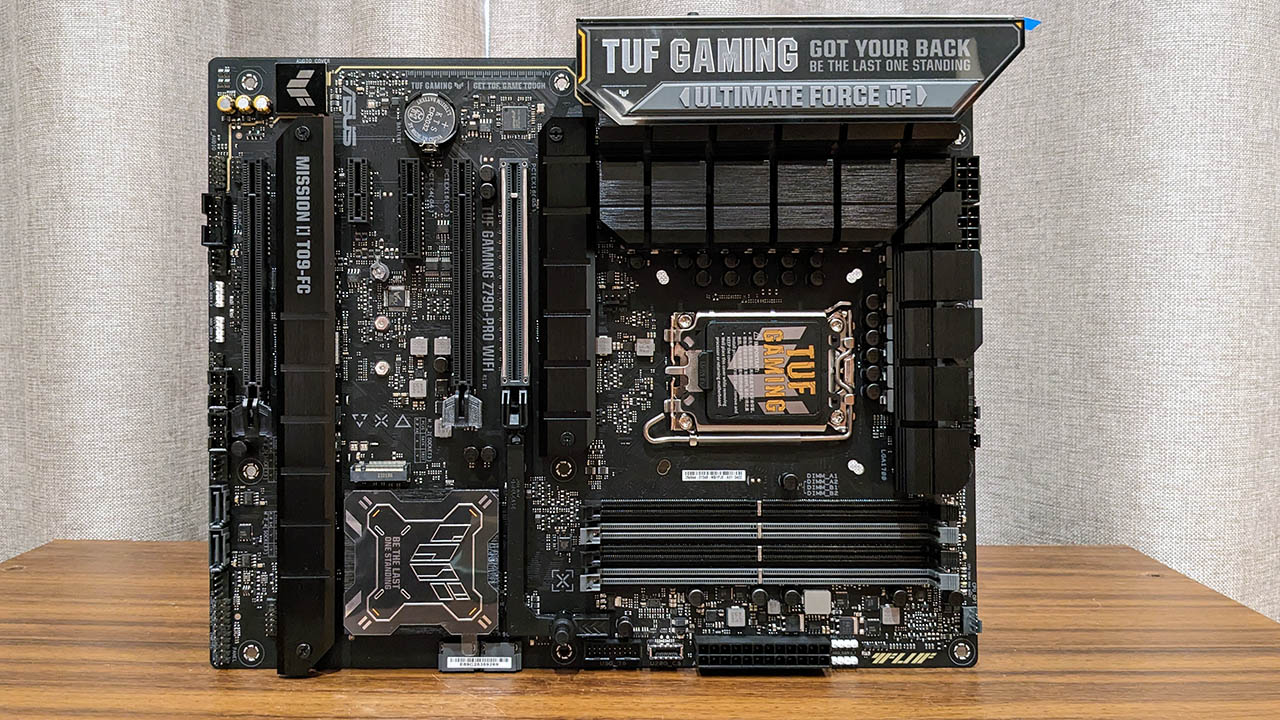






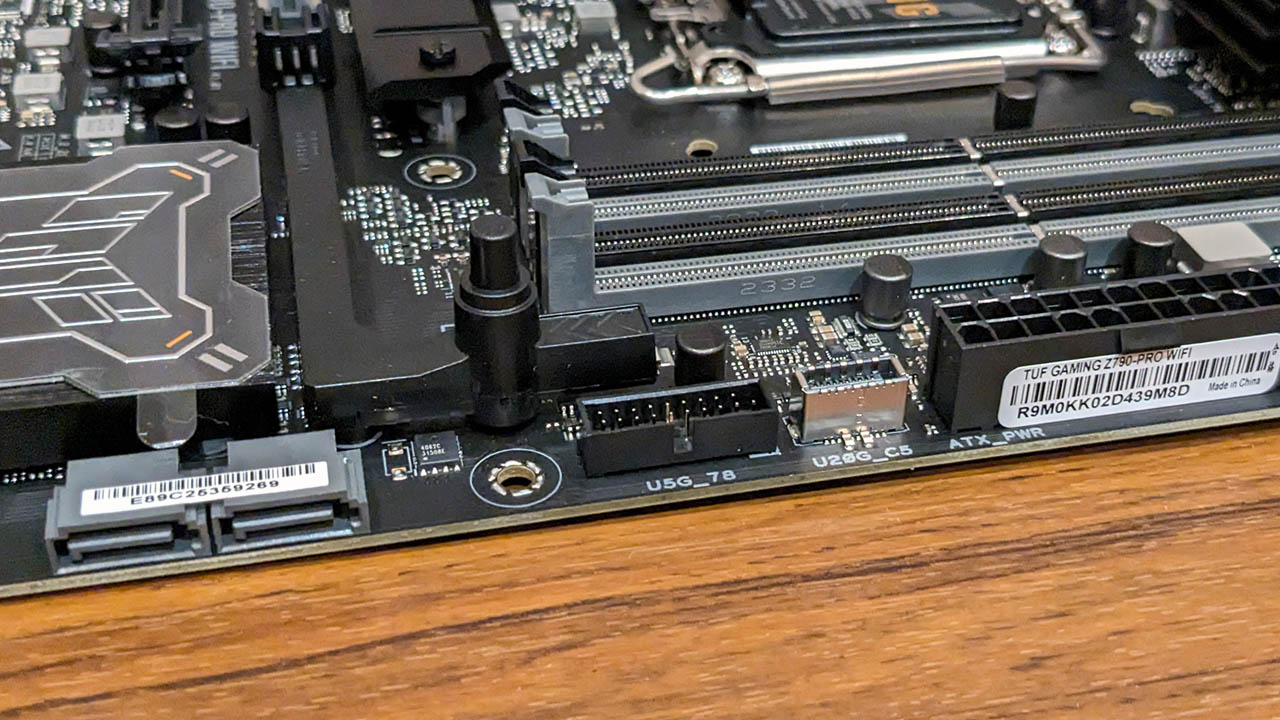


I'll begin with a look at some of the essentials. The TUF Z790-Pro comes with seven fan headers. Not a huge number, but it's enough for an AIO setup and a handful of case fans. There are three ARGB headers plus a single RGB header, a Thunderbolt 4 / USB4 add-in card header and support for two 5Gbps USB ports, four USB 2.0 ports and the aforementioned 20Gbps Type-C port with 30W support. That's a good inclusion for those that want to charge up devices a bit quicker.
The PCIe slot complement is good. It's made up of a single reinforced PCIe 5.0 x16 slot, a PCIe 4.0 x16 slot (x4 electrically), a PCIe 4.0 x4 slot, a PCIe 3.0 x16 slot (x1 electrically) and a physical PCIe 3.0 x1 slot. That gives you a good level of flexibility should you need to install expansion cards.

Socket: Intel LGA 1700
CPU compatibility: Intel 12th, 13th & 14th Gen desktop processors
Form factor: ATX
Memory support: DDR5-7800(OC), up to 192GB
Storage: 4x M.2, 4x SATA
USB: Up 2x USB 3.2 Gen 2x2, 3x USB 3.2 Gen 2, 6x USB 3.1 Gen 1, 4x USB 2.0
Display: 1x DP 1.4, 1x HDMI 2.1
Networking: Intel 2.5G LAN, WiFi 6E
Audio: Realtek S1220A
Price: $299 / £TBD / AU$609
The four memory slots support speeds of up to 7800MHz. Some boards support speeds of 8000MHz or above, But 7800MHz is more than adequate for what is ostensibly a mid-range board. It's a good step up from the DDR5-7200 support of the TUF Z790-Plus. It'll also handle 48GB sticks as expected.
Moving onto the storage complement, the TUF Z790-Pro's primary M.2 slot only supports PCIe 4.0 SSDs. That means you're out of luck if you want to take full advantage of the fastest SSDs. The other three slots all support PCIe 4.0 too. Three of the four M.2 slots are cooled by screw down integrated heatsinks. There are four SATA ports consisting of two in the traditional side position, with another two located at the bottom of the board.
The VRM heatsinks of the TUF Z790-Pro are above average, but are not a match for more expensive boards. I could not read the VRM temperature via software, but I can say a 14900K under an extended load presents them with a challenge. They were on the hot side to touch, though not alarmingly so. Not that too many will run a 14900K in this board, but if you do, good airflow will be a necessity.
The VRM itself is decent for a board in this price range. It's a 16+1+1 design with 60A stages. That's easily enough for an i9 processor and easily capable of powering any other 12th, 13th or 14th Generation processor. Your CPU cooling will stress out long before the VRM does.

The I/O at the rear of the board is best described as adequate. The inclusion of a 20Gbps Type-C port is the highlight. It's joined by three 10Gbps ports (one of which is a Type-C) and four 5Gbps ports. That gives you just eight USB ports. Also, credit to Asus for labeling them according to their speeds, instead of the ridiculous and confusing official various USB names.
The rest of the ports include DisplayPort 1.4 and HDMI 2.1 ports. It's nice to see the inclusion of these higher bandwidth video ports. The omission of CMOS clear and particularly BIOS flashback buttons is notable, though not as critical as it would have been on a 12th or 13th Generation board. The antenna ports are non-standard. Asus calls them Q-Antennas. WiFi support is 6E only, while the single network port supports 2.5GbE speeds.
The boards' audio is provided by a Realtek S1220A codec. It comes with high quality capacitors and a de-pop circuit. It's not a bad solution but the base ALC1220 codec is a few years old now.

Asus TUF Gaming Z790 Pro WiFi performance
System Performance




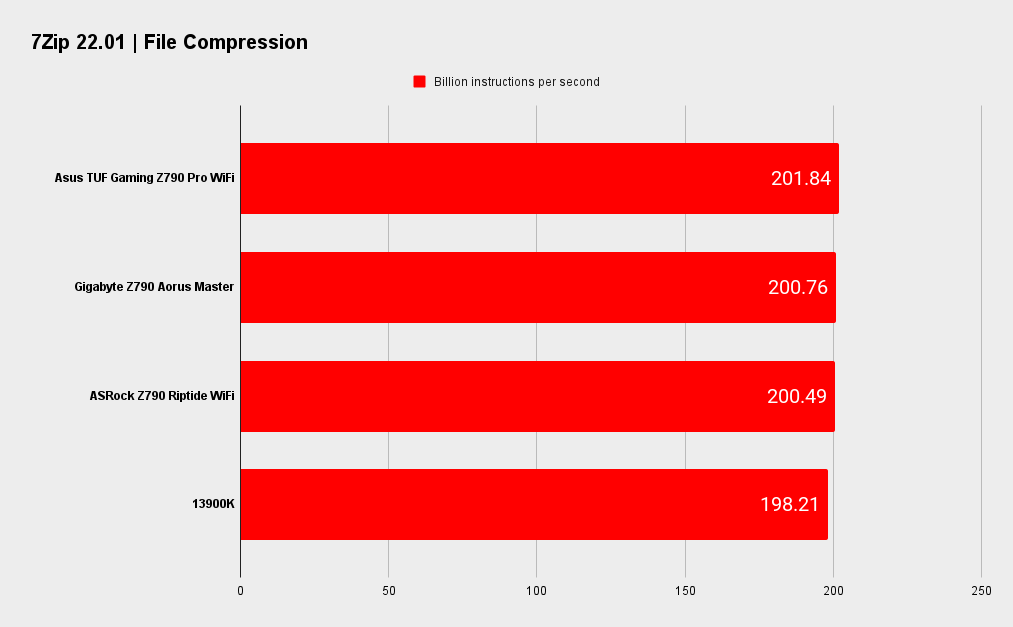

Gaming Performance

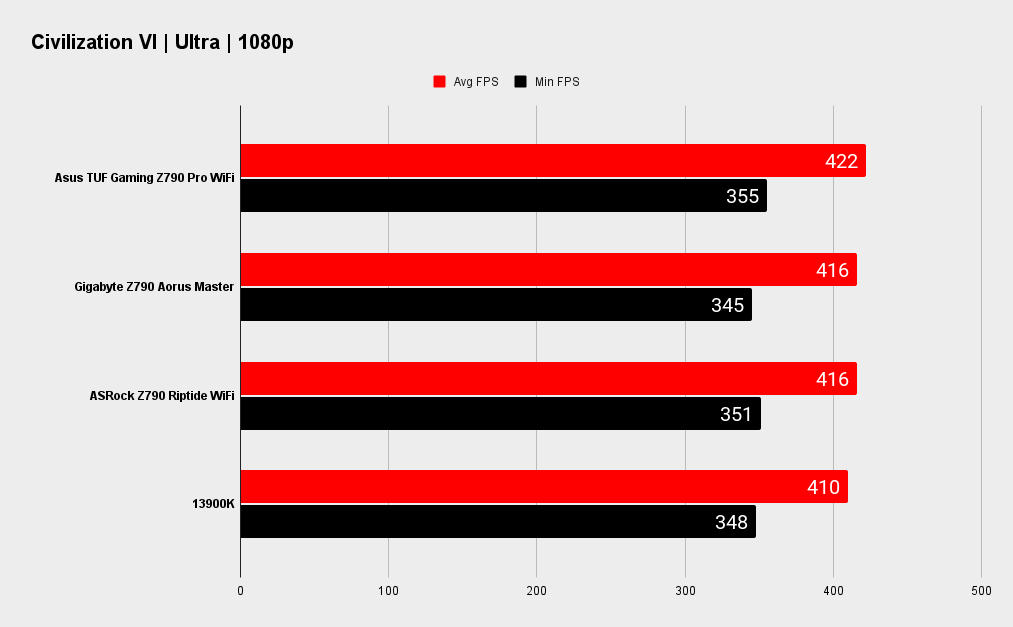
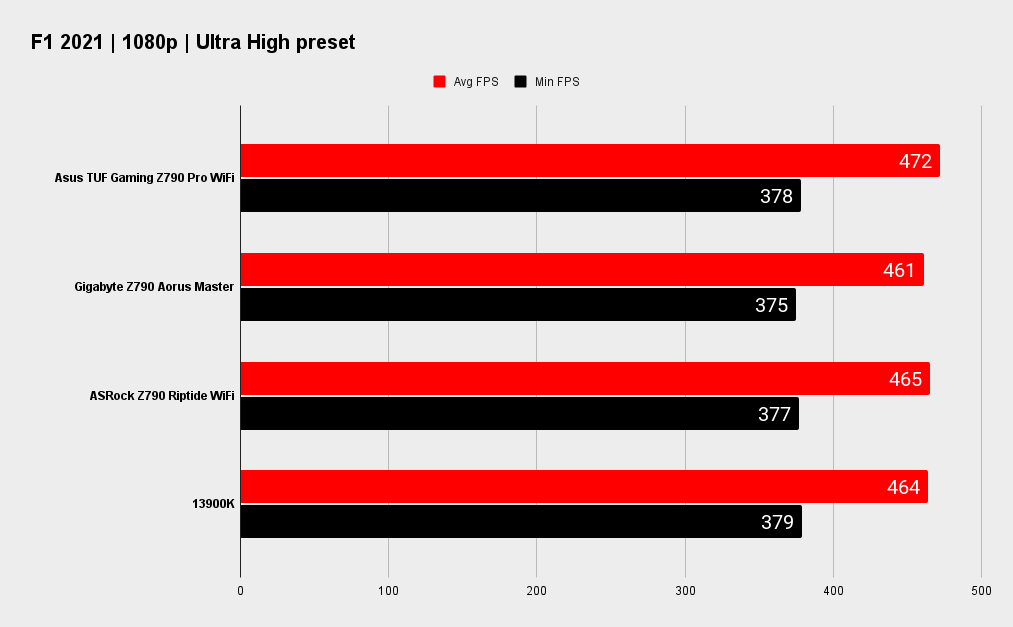


Asus TUF Gaming Z790 Pro WiFi analysis

The benchmark performance of the TUF Z790-Pro is generally good. When comparing it to the three other Z790 refresh boards I have tested to date, It manages to eke out a lead more often than not.
CPU: Intel Core i9 14900K
Graphics: Nvidia GeForce RTX 4090 Founders Edition
RAM: 2x 16GB G.Skill Trident Z5 DDR5-6000 C36
Storage: 2TB Seagate FireCuda 530
Cooling: Cooler Master PL360 Flux 360mm AIO
PSU: Corsair AX1000
Its gaming performance is strong too, though in the end, all Z790 refresh boards are expected to perform very similarly to one another, especially given the engineers have had ample time with Intel's hybrid chips, and the underlying BIOS microcode is mature.
Do note the the 14900K is a very hot running chip. Even my 360mm AIO was not sufficient to stop some instances of thermal throttling when presented with a heavy load.
Given its heat limitations, I didn't even attempt to overclock with the TUF Z790-Pro, You'll certainly have more luck with an older generation chip or an i5 or i7 chip, The 14900K is just too much of an ask to overclock unless you have custom watercooling, The same can be said of the i9 13900K too.
However, memory overclocking is an area that has seen a dramatic improvement. It's partially due to improvements in the 14th Gen memory controller, but Z790 refresh boards have been designed with the faster Hynix chips in mind. I was able to hit DDR5-8000 on this board, something that was impossible for me to achieve with my 13900K sample. That's slightly behind the Gigabyte Z790 Aorus Master X, but that board is close enough to twice the price of the Asus.
Asus TUF Gaming Z790 Pro WiFi verdict

✅You're upgrading from a pre-12th Gen system. Z790 refresh boards are the best of the LGA 1700 generation. The faster memory support and additional features of the TUF Z790-Pro make it a no-brainer choice over its Z790-Plus predecessor. It depends on the street price difference of course.
✅ You want something that's a clear step up from cheaper Z790 boards. The TUF Z790-Pro's stronger VRM & cooling plus USB 20Gbps with 30W charging support are among the reasons to spend the extra cash over an entry level Z690 or Z790 board.
❌ You already have a Z690 or Z790 board. At $299, the TUF Z790-Plus doesn't do enough to distinguish itself from its predecessors. A good Z690 or Z790 board from the last couple of years remains a good one today.
❌ You want WiFi 7. The lack of WiFi 7 is a notable omission, and though not essential right now, it may be one of those features you wish you had when you do get around to setting up a WiFi 7 network.
There are plenty of reasons to like the Asus TUF Gaming Z790-Pro WiFI. It's one of those boards that works equally well before and after you tweak it. In contrast to the early BIOS of Z690 boards and accompanying 12th Gen processors, everything runs smoothly. Its accepts different types of memory its performance is remarkably consistent. Asus' BIOS are rock solid.
I really like it's 30W supporting case header. That will make it easy to charge your devices at your desk, lessening the need to relocate your device to a separate wall charger. Its expansion capabilities via its variety of PCIe slots and VRM capable of handling a fully loaded 14900K are noteworthy. If the TUF Z790-Pro can handle that, it'll handle any LGA 1700 processor you care to throw at it.
But there are two significant shortcomings. Firstly, it lacks WiFi 7 support, which was seen as one of the key differentiating features between 1st and 2nd generation Z790 boards. I don't see that as a deal breaker as personally I have no plans to upgrade my home network to support WiFi 7 anyway, but the second issue is a bigger one.
That issue is price. The TUF Z790-Pro has some very strong competition in its price range. The MSI Z790 Tomahawk Max in particular costs the same, yet includes WiFI 7, more SATA ports, more USB ports and PCIe 5.0 SSD support. It does however, lack that 30W power delivery support and has fewer expansion slots, so it'll be up to you as to what features are most important.
There are plenty of reasons to like the Asus TUF Gaming Z790-Pro WiFI. It's one of those boards that equally well before and after you tweak it.
Many people are happy to pay a little extra for the Asus name. If you do buy it, you'll be rewarded with a highly refined board that's happy with a variety of memory speeds and capacities, features good expansion card support, a quality BIOS, and has that 30W power support.
If Asus were to drop the price a bit, perhaps in line with the TUF Z790-Plus—and it surely will drop in time—then the TUF Gaming Z790-Plus WiFi will certainly become a more compelling option. If only it had WiFi 7…
The Asus TUF Gaming Z790-Plus WiFi is a solid and refined motherboard. Its expansion card support and 30W USB power delivery are standouts, although its lack of WiFi 7 and strong competition prevent it from taking gold in the $300 price range.

Chris' gaming experiences go back to the mid-nineties when he conned his parents into buying an 'educational PC' that was conveniently overpowered to play Doom and Tie Fighter. He developed a love of extreme overclocking that destroyed his savings despite the cheaper hardware on offer via his job at a PC store. To afford more LN2 he began moonlighting as a reviewer for VR-Zone before jumping the fence to work for MSI Australia. Since then, he's gone back to journalism, enthusiastically reviewing the latest and greatest components for PC & Tech Authority, PC Powerplay and currently Australian Personal Computer magazine and PC Gamer. Chris still puts far too many hours into Borderlands 3, always striving to become a more efficient killer.

